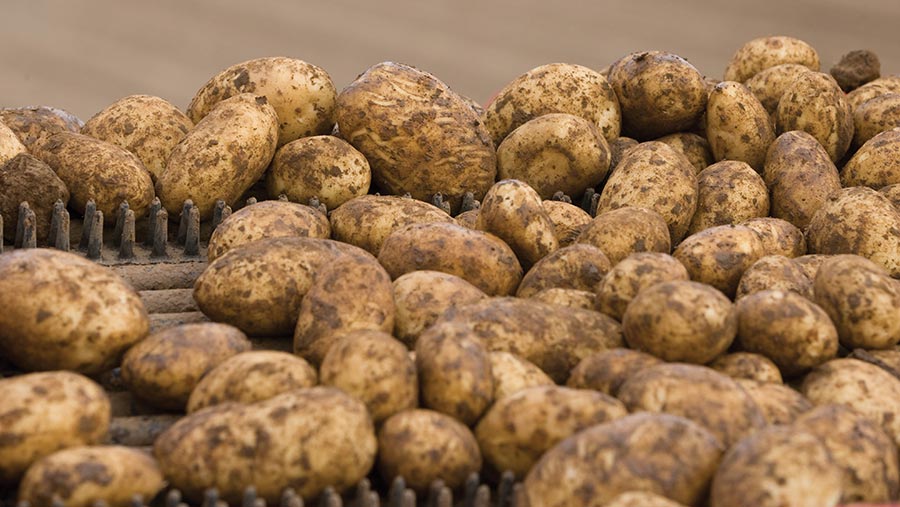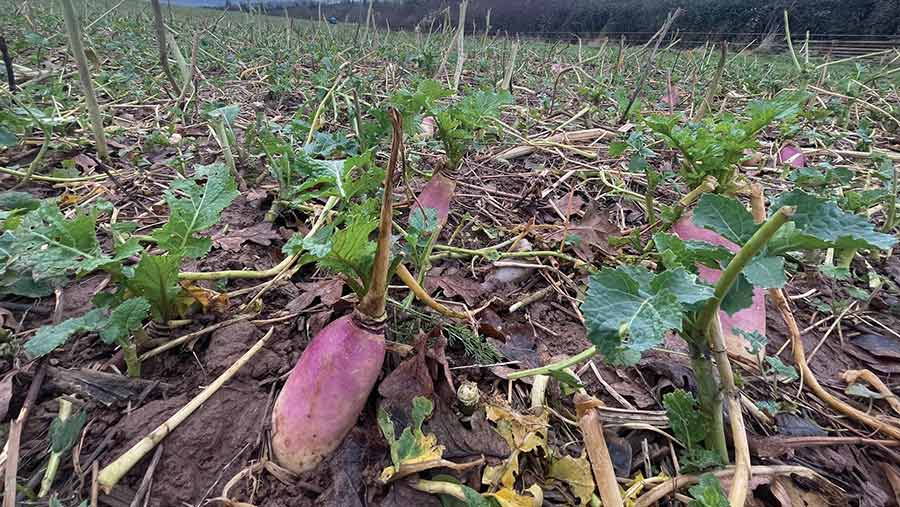Are no-till potatoes a pipe-dream?
 © Tim Scrivener
© Tim Scrivener Initial trials by Dyson Farming and Groundswell Agronomy are highlighting how difficult potato production with zero-tillage is likely to be commercially.
But managing potato crops with reduced tillage, not zero tillage, while embracing other principles of regenerative agriculture is showing more promise.
Dyson Farming is increasingly moving to reduced cultivations in other crops across its farm – ploughing has been reduced by 60% over the past couple of years, with 45% of the area having a cover or catch crop each season, but potatoes are a sticking point, the firm’s Tom Storr says.
A more regenerative approach to potato production would help it maintain the soil improvements resulting from those changes, while potentially also reducing costs and opening potato production to land where it is currently not possible, such as heath land.
See also: Lincs grower moves towards more sustainable potato production
Initial trials in the past two seasons have targeted zero-till potatoes, with 120 seed potatoes planted under straw in 2021. Establishment was patchy, after mice and slugs severely reduced emergence.
“They were also generally about three weeks behind in their growth stages compared with conventionally grown potatoes alongside,” Mr Storr says.
“If we were going to do this on a commercial scale, we would likely have to plant much earlier.”
Sample digs suggested strawed potatoes with no seed-bed nitrogen yielded about 48t/ha compared with around 68t/ha for conventionally grown potatoes.
Common scab levels in strawed potatoes were lower, perhaps because of keeping potatoes moist for a continued period.
Harvesting with a commercial trailed machine was possible with a generally clean sample, although the odd bit of straw did come through.
A larger area to set up the harvester should prevent that, or use of a self-propelled machine with a better cleaning system, Mr Storr suggests.
The trial is being repeated this season in 50m beds, strawed with and without seed-bed nitrogen, and another bed covered with digestate.
Pest problems
Inspiration for Dyson’s trials came from seeing a no-till demonstration at Groundswell in 2015, which was repeated at the event this year.
Emergence has also been patchy, with mice and slugs an issue, says Richard Harding from Groundswell Agronomy.
Another challenge is the following rotation with large amounts of trash, he says. “Our idea is to plant a wide-row crop, such as sweetcorn or squash, to grow a high-value crop, while allowing the trash to continue to breakdown, before planting a cereal crop.”
An alternative approach, which Ben Taylor-Davies has implemented on his 32ha of potatoes in Herefordshire, is to do everything possible to mitigate against the cultivations required for potatoes.
“I tried with a system crimping rye, applying compost to plant potatoes on top, ticker tape irrigation and strawing, to see if we could grow potatoes commercially. We did it enough to know we lost so much money we couldn’t carry on,” he says.
It led him to realise cultivations might not be as bad as some suggest. “Nature regenerates itself through flood, fire, famine or massive hoof impacts, so are cultivations that bad?” he asks.
“So I’ve changed tack and thinking of potatoes as the fire, famine part of my rotation.”
Cover crop
His potatoes follow a spring crop, with a large biomass overwinter cover crop planted in between, which is grazed with sheep to take initially 70% of the growth, with the remaining 30% grazed just before potatoes are planted.

© Ben Taylor-Davies
Planting is in a single pass with a bedtiller and planter. “At the point of planting, we’re using Johnson-Su compost extract, focusing on putting biology back as we disturb the biological balance of the soil.”
By packing the soil with biology, he claims potato cyst nematodes and rhizoctonia are held at bay. He also plants buckwheat, peas and vetch at the same depth as the tubers as a companion crop.
“The vetch and buckwheat acidify the rhizosphere around the potato tuber, which solubilises more phosphate, along with the Johnson-Su extract so we can mine the huge amounts of phosphate in our soils.”
With peas and vetch also fixing nitrogen, plus what was in the cover crop, Mr Taylor-Davies is finding he only needs to apply 10 kgN/ha of urea-based foliar nitrogen, with added sulphur and carbon.
The other role of the companions is to encourage beneficial insects into the potato crop.
“If you walk through a flowering crop before it’s flowering there’s often a lot of beneficials already there,” he says.
“Plants have an amazing ability to leak out nectar from their stems to start building numbers up before the flowering starts.
“Off the back of that, ladybirds, lacewings and hoverflies build, which has a huge effect on aphid populations.”
He’s changed nutrition, too – moving away from chloride forms of potassium as the salts exacerbate problems and make crops thirstier. That has enabled a reduction in irrigation.
He uses sap analysis to unlock understanding of plant health, with foliar applications of magnesium sulphate, even though the soil is magnesium-rich, helping give better responses to potassium, phosphate and nitrogen applications. “We manage excesses rather than deficiencies.”
The crop is lifted at the end of August, which is when blight often comes in the crop. Lifting earlier helps reduce the number of blight sprays required – last year he didn’t apply any.
After harvest
After lifting, during which he avoids trafficking the field with trailers, he immediately plants a cover crop to start the process of remediation.
“We’re doing soil carbon measurements through the rotation, and last year we had no decline in our carbon levels after potatoes. It’s one year, one trial, but we’re repeating it this year.”
That type of mitigation approach is more likely the direction Dyson Farming will ultimately take, Dr Storr admits.
Multi-variety direct to consumer plan
After consumers liked buying eggs of different colours from his farm, Ben Taylor-Davies is contemplating producing a multi-variety pack of potatoes with explanations about which ones would be suitable for different styles of cooking.
“Essentially, it would be providing a pick-your-own, free-range selection.”
That’s following a decision to plant seven to nine different species of processing potatoes this season. “Diversity is something we are aspiring to. We know blends work with wheat, barley and other crops.
“It does create its own problems about whether to separate, or use straight into the processor as a blend, or produce these multi-variety bags for a supermarket.”
“Across our businesses we’re looking at cover crops where we can, but also when and what type of cultivation we’re undertaking. Across the majority of our potato area we’re still ploughing, bed-tillering and bed-forming passes.
“I think where we’d like to get to is whether we need to do two passes with a bed-till, or even one pass. That’s why it’s interesting looking at the progression of the cultivation trials where we compare yields from growing under straw with plough, bed-form and plant, and plough, bed-tiller, bed-form, and destoning if it needs it.
“The results are showing there’s not much difference in yield in taking out one cultivation – it then becomes about quality and ease of harvest.
“If potatoes under straw has legs commercially, I think we would still be reliant on some form of cultivation to soften up the surface to avoid machinery damage,” he concludes.
Ben Taylor-Davies, Richard Harding and Tom Storr were speaking in a seminar session titled “Do potatoes have a place in a regen system?” at the Groundswell event held earlier this year in Hertfordshire
